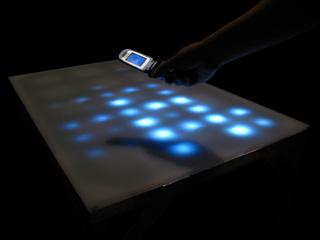Table for Electronic Dreams
Andrew Doro
Table for Electronic Dreams reveals the invisible workings of electronic devices and the limits of human perception.
http://sheepish.org/table/

Electronic objects are not only "smart", they "dream" – in the sense that they leak radiation into the space and objects surrounding them, including our bodies. Despite the images of control and efficiency conveyed through a beige visual language of intelligibility and smartness, electronic objects... are irrational – or at least allow their thoughts to wander. Thinking of them in terms of dreaminess rather than smartness opens them to more interesting interpretations.
- Anthony Dunne, Hertzian Tales
Since the invention of radio by Nikola Tesla and Guglielmo Marconi in the late nineteenth century, the electromagnetic spectrum has become increasingly noisy and dense. We communicate through this invisible medium through our electronic devices- radios, cellphones, WiFi, bluetooth, etc. but we do not have direct access to this medium or an awareness of its invisible contours.
I have created a table which reveals the hidden electrical activity of electronic objects placed upon it. Through this interaction, people will develop a greater awareness of the invisible aspects and workings of their electronic devices, and the limits of human perception.
Background
Industrial designers Anthony Dunne and Fiona Raby have coined the phrase "Hertzian space" to describe these invisible fields which pervade space. Dunne and Raby stress that this is a real space, although we only interact with it through our devices. By creating a table outfitted with circuitry which responds to low-frequency electromagnetic radiation, some of the activity in Hertzian space can be made visible. I have constructed a table which will reveal the hidden electrical activity of electronic objects placed upon it. By doing this, users will develop a greater awareness of the invisible aspects and working of their electronic devices.
Audience
Anyone who is curious about their electronic devices, science and human perception.
User Scenario
Whenever a person places any electronic object on the table (e.g. cellphone, laptop, iPhone) the electrical activity is translated into light. They will see the periodic pulse from their cellphone, which suddenly splashes out when a phone call is received. Users will discover a hidden personality to their electronic objects, for example that some phones emit more radiation than others.
Implementation
The table contains a grid of circuits which detect and translate electromagnetic activity through magnetic induction coils. The circuits are hidden underneath a surface of translucent white acrylic.
Each circuit consists of a magnetic pickup connected to an operational amplifier (op amp), which amplifies the detected signal. The amplified signal powers a high-flux white light emitting diode (LED). There are 60 identical circuits in a 6 by 10 arrangement with each LED three inches apart. The 60 circuits are contained on 15 printed circuit boards each containing 4 op amps.
Conclusion
I learned how to build furniture, approximately.